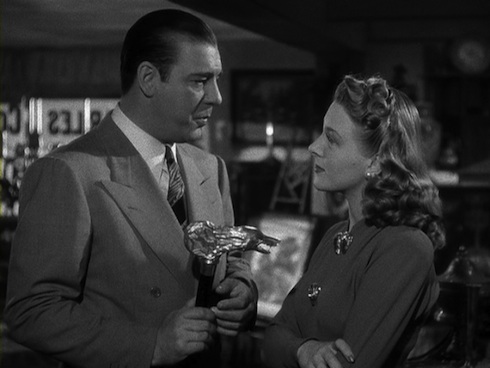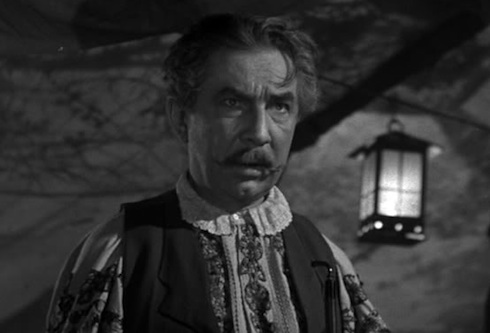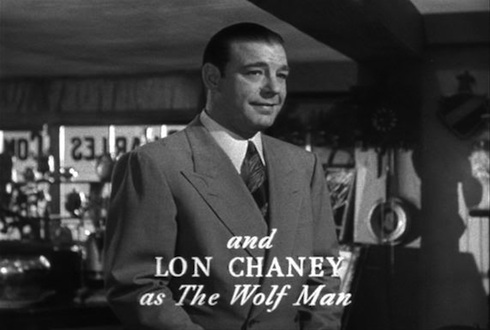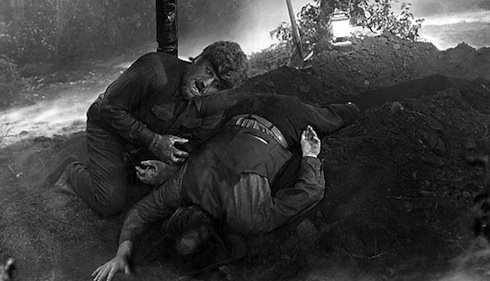The reason we love monsters so much is because we invariably see something of ourselves in them. Through the Gill-man we reflect on our own understand isolation and loneliness. The Mummy helps us grapple with unrequited love, while Dracula warns us against our arrogance. Meanwhile, Frankenstein’s monster emphasizes the importance of having the right shoe size. All of this connects with us because we are all sometimes like monsters, with our own “monster powers” which we too worry about releasing upon the world.
The Wolf Man is perhaps the most fitting of these classic films to end our mash on, because it is a film where “the monster” and the “good guy” are literally the same character.
The Wolf Man begins with a large book opened to definition of the word “lycanthropy” which we learn deals with the phenomena of werewolves and how they work. This may seem a little like a storybook at the start of a Disney film, but it’s perfect here because it gives the movie some pathos. Any savvy viewer will know that lycanthropy isn’t just about werewolves, but also a real clinical disorder, where people actually believe they’ve been transformed into animals. Like King Kong, The Wolf Man is already asserting a meta-fictional conceit, albeit one very different one from Kong. Whereas Kong was talking about how the pursuit of monster stories creates real monsters and monstrous events, The Wolf Man is exploring the terrible quandary of realizing you are the monster both in your own head, and in real life, too.
Lon Cheney Jr. plays Larry Talbot, a man returning back to his father’s estate in England after being away in America for nearly 18 years. Larry has an estranged relationship with his father, Sir John Talbot (Claude Rains), and has only come home because of a recent hunting accident that claimed the life of his brother. This does nothing but favors for the movie as the relationship between Larry and his father is non-traditional, at least in contrast to how people are commonly portrayed in these monster films. Adding to this is the very real fact that Lon Cheney is not traditionally handsome at all, but still totally charming. Larry is a man who knows how to work with his hands, and has a sort of aw-shucks quality that wins you over, despite how forward he is with a certain lady named Gwen (Evelyn Ankers). While repairing his father’s telescope, Larry spies Gwen who lives and works across the street in an antique shop. He decides to go over there and hit on her with some creepy “I just checked you out through a telescope” pick up lines, which seem to work, at least partially.

However, even though Gwen sells Larry a seriously sweet walking cane complete with a silver werewolf head at its top, she does kinda reject him. Initially, we’re not told why, but when Larry shows up later to try and get Gwen to go out with him, she’s randomly brought along an annoying gal pal. Larry takes it all in stride and the three head off to get their fortunes read by the traveling gypsies. Luckily, for them, (and for us) none other than Bela Lugosi plays the main fortuneteller who is of course just named Bela! This little bit is nice, but also allows the The Wolf Man proceeds to start getting even more meta than you might have initially thought! (If you’re thinking Bela might be the one who ends up biting poor Larry and turning him into a vampire werewolf, then you’re a genius.)
While Gwen’s annoying friend Jenny (Fay Helm) gets her fortune told, Larry tries to take Gwen for a sexy stroll in the woods where she reveals to him she’s engaged. Bummer for Larry! But this too is a great turn for the film, as the moral relationships between the male and female leads are subtly being subverted. We can tell Gwen likes Larry, and why not? We like Larry, he seems like a good guy to hang out with, and he’s sort of figuring his life out again by helping his dad sort of pick up the pieces after his brother’s death. But we also know a nice girl like Gwen shouldn’t be going on a half-assed date with a guy and sort of flirting and leading him on when she’s engaged. This is all going to end in tears, and Larry hasn’t even become the Wolf Man yet. All of this is good stuff, because the real-life stakes of the characters’ hopes and dreams are central to the conflict, well before a supernatural element is introduced.

Bela is of course a werewolf and when in full wolf-form (onscreen this just looks like a German Shepard) he kills Gwen’s friend Jenny. Larry and Gwen rush to see what has happened and Larry beats the wolf to death with his cane. But of course when the cops come to check out the scene of the crime, a very human Bela is lying there dead and not a wolf. Bela also managed to bite Larry just before he died, so the torch from one monster to another has been subtly passed.
Notably, a full moon is NOT necessary for someone to transform into a werewolf. Instead, this little nursery rhyme is repeated a few times:
Even a man who is pure in heart and says his prayers by night
May become a wolf when the wolfbane blooms, and the autumn moon is bright.
The source of this little ditty isn’t from some kind of ancient werewolf lore, but instead a creation of the screenwriter Curt Sidomak. Like The Mummy, The Wolf Man does not have a direct literary source from which it is drawn. But where this hurts some of the plotting and thematic elements of The Mummy, the writing of the The Wolf Man feels fresh, spry, original, and honest. And though there’s no evidence of this, I can’t help but feel like there may have been some inspiration from Herman Hesse’s wonderful novel Steppenwolf. When Larry’s father is speaking of the notions of what goes on inside our heads, I felt at the very least that I was supposed to believe that this character had read that novel. Of course, Universal Pictures had done another werewolf movie in the form of Werewolf of London, but it is with The Wolf Man where it all really came together in a perfect pop masterpiece. And this because the movie is ultimately about a man’s struggle to suppress what he knows is going to happen: he will become a killer. And unlike a Jekyll and Hyde type of story, it’s through no fault of his own.
Eventually, poor Larry becomes the Wolf Man and starts killing people around town. This eventually leads to a full on hunt to trap whoever or whatever is causing all of this. After a lot of soul searching, Larry tells his dad what is really going on, which his father refuses to believe. To help cure Larry of what he believes to a delusion, the elder Talbot ties his son to a chair, while the hunt is proceeding. This, he feels will prove to Larry that he will not become a wolf. But the viewer can sense Larry’s father is having doubts about this, and at the height of the hunt, he turns back to the estate, rushing to check on his son. At this point, Larry has turned in the Wolf Man and is running around like a maniac. We’ve been told now that only a silver bullet, or a hardcore beating with something made of silver, can kill the monster. Tragically, the film ends with John Talbot beating the Wolf Man, his son, Larry, to death with the very cane Larry used to kill the previous werewolf, Bela. As Gwen and her annoying fiancé Frank look on, the Wolf Man turns back into the nice guy they all knew. The final line of the film is wonderful. Gwen simply says, “Oh” and then, “Larry.”

From pacing, to camerawork, to music, to the performances of the actors, and especially the good, honest decent writing make The Wolf Man a stand out among classic monster films. If you don’t feel a pang of guilt and horror as the tragedy of the Talbot family unfolds, then you’ve yet to grasp what these monster movies are all about. Real people.
Ryan Britt is the staff writer for Tor.com.











And his hair was … well, you know.
I’ll always have a soft spot for the Wolfman because it was one of the first movies I remeber seeing. I was in the children’s hospital in palo alto california for surgery when I was around 4 or 5 years old. They showed this classic monster movie to all the kids in the hospital for Halloween. My Mom wasn’t so sure I should watch it because it might be to scary for me. She figured I’d be okay after I asked,”Mommy why is the man changing into a doggy?” It’s still one of my favorites to this day.